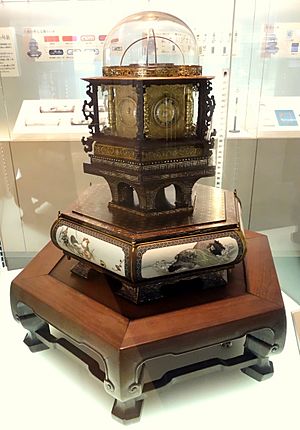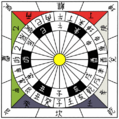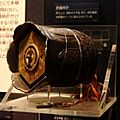Japanese clock facts for kids
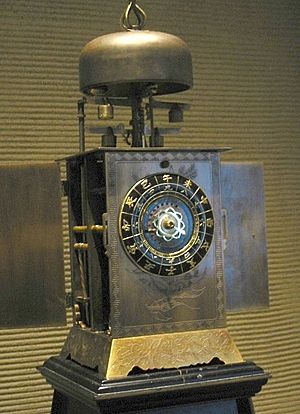
A Japanese clock is a special kind of clock that tells time the traditional Japanese way. These clocks first came to Japan in the 1500s. Jesuit missionaries brought them. In 1612, a clockmaker from Philip II of Spain made a clock. It was a gift for Tokugawa Ieyasu, a powerful leader in Japan.
What makes Japanese clocks special? They could measure "unequal hours." Normal clocks have hours that are always the same length. But in old Japan, daytime was split into six hours, from sunrise to sunset. Nighttime was also split into six hours, from sunset to sunrise. This meant daytime hours were longer in summer and shorter in winter. Nighttime hours were the opposite. Japanese clocks were built to handle these changing hour lengths!
How Japanese Clocks Told Time
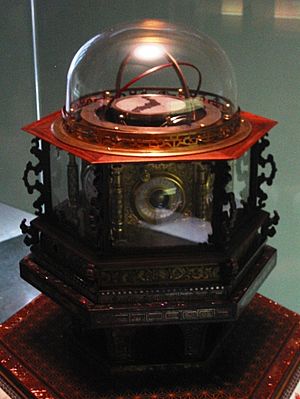
Traditional Japanese clocks had six numbered hours. These numbers went from 9 down to 4. They counted backwards from noon until midnight. The numbers 1, 2, and 3 were not used. This was for religious reasons. These numbers of bell strokes were used by Buddhists to call people to prayer.
The count ran backwards because the first Japanese timekeepers used burning incense sticks. These sticks would burn down to mark time. So, time was counted as it decreased.
Besides the numbers, each hour also had a sign from the Japanese zodiac.
Daytime Hours
Starting at dawn, these were the six daytime hours:
| Zodiac sign | Zodiac symbol | Japanese numeral | Strike | Solar time |
|---|---|---|---|---|
| Hare | 卯 | 六 | 6 | sunrise |
| Dragon | 辰 | 五 | 5 | |
| Serpent | 巳 | 四 | 4 | |
| Horse | 午 | 九 | 9 | noon |
| Ram | 未 | 八 | 8 | |
| Monkey | 申 | 七 | 7 |
Nighttime Hours
From dusk, these were the six nighttime hours:
| Zodiac sign | Zodiac symbol | Japanese numeral | Strike | Solar time |
|---|---|---|---|---|
| Cock | 酉 | 六 | 6 | sunset |
| Dog | 戌 | 五 | 5 | |
| Boar | 亥 | 四 | 4 | |
| Rat | 子 | 九 | 9 | midnight |
| Ox | 丑 | 八 | 8 | |
| Tiger | 寅 | 七 | 7 |
Images for kids
-
Two separate foliot balances allow this 18th-century Japanese clock to run at two different speeds to indicate unequal hours.
-
The traditional Chinese 12 Earthly Branches and 24 Cardinal Directions; the 12 Earthly Branches are the basis for the zodiacal assignments of the Japanese hours.
See also
 In Spanish: Reloj japonés para niños
In Spanish: Reloj japonés para niños


